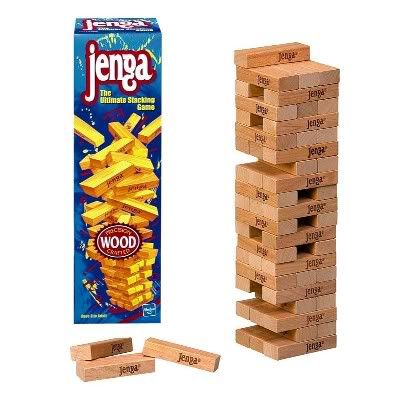My late-edition Milton Bradley basic Jenga set (the blue box) has a set of 54 supposedly identical “precision cut” wooden blocks. The blocks are unpainted, are wonderfully smooth and weighty, and have the Jenga logo embossed on one side. The whole thing comes in a box that allows the players to haul the tower out in the “reset tray” ready to play.

The Game
The game as described in the rules is quick and easy. The blocks begin stacked as an 18-story tower, three blocks to a story, alternating stories perpendicular in orientation. The object of the game is to build the tower higher by taking blocks from the lower stories and adding them to the top of the tower. A full three-block story must be completed at the top of the tower before beginning a new story.
Players alternate turns pulling blocks from the lower levels and stacking them atop the tower. Players may only use one hand, and may probe the tower but may not move a block without taking the block. Eventually, a player will cause the tower to collapse either due to pulling a wrong block, or by making a mistake in stacking the block atop the structure. The rules say that the last player to successfully take a turn wins.
Cooperative play
I don’t much like the game’s original winning condition. It seems to ignore that all the players were involved in building the Jenga tower.
I first encountered Jenga in a corporate team building activity. The group was split into teams of three. Each team was given a Jenga set. The objective of the game was for each team, following the standard Jenga rules, to try to build the tower as high as they could. The team that built the tallest tower, without the tower collapsing, won the game.
This cooperative play mode appeals to me much more than the standard rules. This way, each player has a stake in making sure that the tower survives. There’s a luck-pushing aspect, since a collapsed tower cannot win. However, if one of the other team has already surpassed the height of your tower, you have no choice but to keep trying to go higher. In the case of a tie, the team that first gets to the highest level is the winner. So if all you do is tie, you need to go one level higher.
The reward of that game was substantial – it was a week of paid vacation time for each of the winning team members. My team won with a tower height of 32 stories. All the other teams collapsed their towers trying to beat 32 stories. I never did get to take that vacation – good thing it was eligible to be converted into cash.

Strategy
Hey, it’s a dexterity game coupled with a bit of basic physics. Keep the tower’s center of gravity running straight down through what’s left of your original 18 stories. It’s likely that you’ll end up with alternating stories of one block, then two blocks, then one block and so on. I believe that that’s the minimum structure that will support the increasingly heavier top, but I could be mistaken. Poke gently – if the block doesn’t slide out easily, forget it. Taking that block out will likely collapse the tower. Stacking the blocks on top is a way to control where the weight of the whole structure is resting. It’ possible to manipulate which blocks will come loose, but it makes it increasingly difficult to keep the tower’s center of gravity running straight down. Do it at your own risk.
Reviewer’s Tilt
So. How many words can one write about 54 wooden blocks? Quite a lot I guess. I still like Jenga, but I truly believe that its best application is in a cooperative mode against other teams as described above. Others may like it better as a drinking game, because impaired dexterity and a clouded mental state might make the game more entertaining. Sure, whatever floats your boat, but cooperative play provides an opportunity for people to work together towards a common goal, to challenge themselves, and to experience a game that’s not exactly as common as Scrabble or Monopoly. Jenga may not be the fanciest of dexterity games, especially when compared to the newfangled ones like Villa Palletti or Hamsterrolle, but it still fits the bill in correct circumstances.
No comments:
Post a Comment